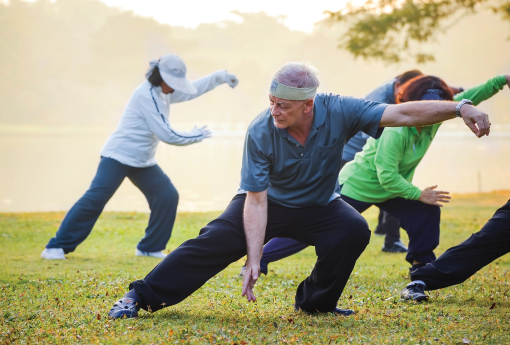The Arthritis Newsletter
Spring 2017Benefits of Tai Chi for Chronic Conditions
 Dr. Michael Hunt is an Affiliate Scientist at Arthritis Research Canada and a clinical biomechanist and Associate Professor in the Department of Physical Therapy (UBC). Recently, he and his colleagues completed a review of previous studies on the effect of Tai Chi when practiced by individuals with four common chronic conditions (cancer, osteoarthritis, heart failure and chronic obstructive pulmonary disease).
Dr. Michael Hunt is an Affiliate Scientist at Arthritis Research Canada and a clinical biomechanist and Associate Professor in the Department of Physical Therapy (UBC). Recently, he and his colleagues completed a review of previous studies on the effect of Tai Chi when practiced by individuals with four common chronic conditions (cancer, osteoarthritis, heart failure and chronic obstructive pulmonary disease).
What is Tai Chi?
Tai Chi is a low to moderate intensity physical activity, also known as QiGong (pronounced Chi Gong). This ancient Chinese physical activity has become popular, particularly for older adults. All styles consist of slow gentle and flowing movements that involve strengthening, balance, postural alignment, mind concentration, relaxation and breath control. It can be performed in a class setting or individually, both outdoors and indoors with no investment in equipment.
How was the review done?
Four scientific databases were searched (MEDLINE, EMBASE, CINAHL AND SPORTDiscus) and after screening from those sources, 33 studies met the criteria for inclusion into the review. We used meta analyses, which is a procedure for combining data from multiple studies to identify a common result.
All studies had randomized control groups and used some or all of the following outcome measures: walk test (six minutes), muscle strength (knee extensor strength), timed get up and go, quality of life, depression and physiological outcomes. Tai Chi programmes in the study were of different lengths and intensities, but were typically 12 weeks long, mostly one hour sessions, usually offered 2 to 3 times per week.
What results did you find that relate to OA specifically?
Of all the diseases studied, the most positive effects were with osteoarthritis patients. Pain and stiffness, knee strength, and the timed get up and go and sit to stand times all showed improvements after Tai Chi. Other physical performance measures that require knee extensor strength also improved after Tai Chi.
What is the most important finding?
Tai Chi has the potential to improve functional exercise capacity, or the ability to perform activities of daily living, but not at the expense of aggravating pain or causing difficult breathing. It may also be “easy on the joints” due to the low impact nature of the activity. Therefore it may be prescribed for people with a number of disease conditions (e.g. cancer and osteoarthritis or heart failure and osteoarthritis).
Tai Chi classes are widely available through Tai Chi schools and many community centres. Many offer a free introduction to Tai Chi so that you can try it.
Congratulations to Dr. Michael Hunt on being awarded a Killam Research Fellowship from the University of British Columbia (UBC)
For more information on Michael Hunt and the Motion Analysis and Biofeedback Laboratory, please visit http://mablab.rehab.med.ubc.ca/


























































